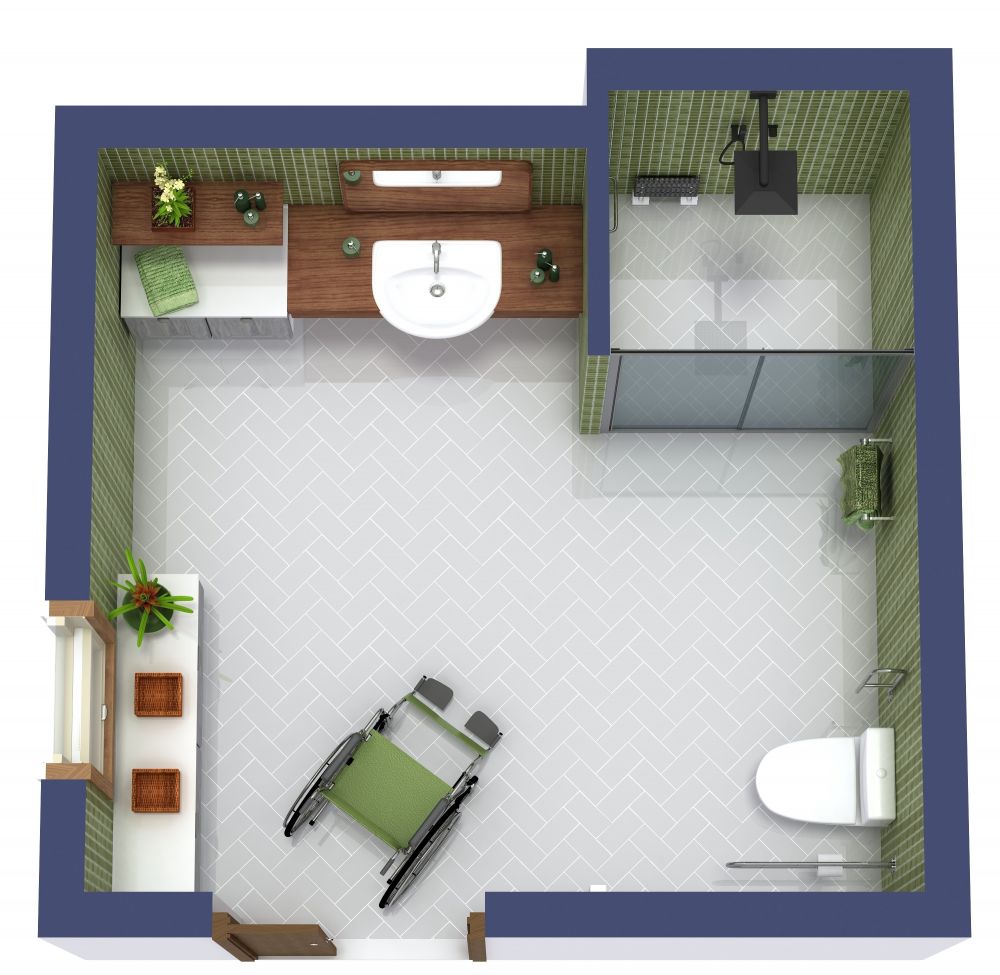Accessible Bathroom Floor Plans
Accessible bathrooms are designed for anyone with limited mobility. These days, many people want to “age in place” and remodel their home bathrooms with an eye towards future requirements. Other homeowners or builders add accessibility features specifically for people with disabilities or anyone who needs extra assistance. Elements you may see in an accessible bathroom include wider doors, flat thresholds, grab bars, extra open space, clearance under the sink, and more. Let’s take a look.
Read More
The Bathroom Entry
Most bathroom guides recommend that an accessible bathroom door be 36 inches (91 cm) wide if possible. This will allow easy access for a standard wheelchair, which is 24 -27 inches wide (approx. 61- 69 cm). If you don’t have quite enough space for such a wide door, at a minimum, choose 32 inches (81 cm), which can still accommodate a wheelchair or walker if needed. Additionally, a completely flat threshold at the door entry is ideal for smooth rolling access.
Wheelchair Rotating Space
You may notice a circular wheelchair symbol on accessible bathroom floor plans. The symbol demonstrates the clearance needed to turn a wheelchair. The turning radius should be 60 inches (152 cm) in diameter.
Sink Height and Clearance
The sink and vanity counter height is an important consideration for mobility. When standing at the sink, you don’t want to have to bend over too far. Depending on your height, you may want a 36 inch (about 91 cm) vanity height so that you don’t have to hunch over.
That being said, if you are designing a bathroom for a wheelchair user, the sink should generally be mounted at a lower 34 inches (86 cm) as any higher will not be accessible for a seated person. In addition, choose either a pedestal sink or a vanity with an open area underneath (rather than drawers or cabinets) to allow the wheelchair user to roll directly up to the sink. The recommended open area is 28 inches high (71 cm) measured from the floor to the bottom of the counter, 30 - 36 inches wide (91 cm), and 11 to 25 inches (64 cm) deep, measured from the front of the counter. These measurements can all be adjusted for the specific user. In addition, the floor area below the sink should be completely clear, and be sure to insulate any exposed pipes.
Space Around the Toilet
Clear space in front of and next to the toilet is very important to be able to roll a wheelchair close and facilitate a transfer. The toilet’s centerline should be 18 inches (46 cm) from any side wall to allow space for a grab bar. Additionally, leave about 40 inches (102 cm) to one side of the toilet to allow transfer space from the wheelchair to the toilet. In front of the transfer space, allow a 60 inch (91 cm) turning circle for rotating the wheelchair. Additionally, consider a “comfort height” toilet which is taller than the standard height. This is helpful for many users as it requires less strain on the back and knees as one sits and stands up.
Shower and Bath Considerations
An accessible bathroom floor plan often includes a shower rather than a bathtub for easier access and safety. Additionally, the shower space should be generously sized, as a caregiver or spouse may need to help with the bathing process. The recommendation is generally 36” (91 cm) wide and 60” (152 cm) deep. The shower entry should also be 36” (91 cm) wide and ideally flat (curbless) or so that a wheelchair can roll directly in. If you add a bench to the shower, one good option is a fold-up bench that can be moved out of the way if needed. Or, add a simple shower chair or stool. Other universal design ideas include a handheld shower and several grab bars.
If you do want to include a bathtub, one option is a specialty walk-in tub that contains a small door. Another option is to install a grab bar near the tub entrance, plus install the tub into a surround with a wide ledge on which a person can sit and rotate their legs into the tub.
Accessible Design Standards
A useful reference is the Americans With Disabilities Act (ADA), which provides design standards to help people with disabilities, including guidelines for bathroom design. While private homes (and homes outside the United States) don’t have to adhere to ADA guidelines, they can be a helpful reference when designing an accessible bathroom. We’ve included some of the guidelines in this topic, as well as examples of accessible floor plans
Are you ready to design an accessible bathroom floor plan? Once you’ve studied up on accessible features, use our templates to try out your design ideas and find your perfect layout.